Let us all stand gasping in awe at the majesty of The Sea Bat!
How the hell did this movie slip past my notice?
Released in 1930 by MGM, "The Sea Bat" screened this week on Turner Classic Movies. Intrigued by the description, which said something about Raquel Torres seeking vengeance on a giant sting ray that killed her husband, I set the DVR and forgot about it. I knew Raquel Torres (real name Paula Osterman -- though she was Mexican) from "Duck Soup," so I figured the Marx Brothers connection alone was worth tuning in for. Plus, that whole "giant sting ray" angle sounded interesting. I've seen a lot of movies about giant monsters, but I had to admit, I hadn't seen one of those before. Plus, I was curious to see how the special effects would be handled. 1930, keep in mind, was a year before the horror movie boom began with 1931's "Dracula" and "Frankenstein" and three years before the giant monster classic "King Kong."
So the next day I plopped down on the couch, fired up the remote and was greeted with this...
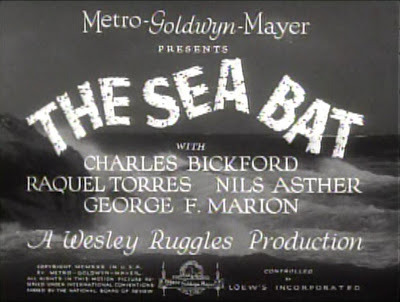
Though his name is big (and italicized!), director Wesley Ruggles was, according to the occasionally reliable Internet Movie Database, replaced during filming by none other than the great Lionel Barrymore, which by itself makes this movie worth a look. And, I'm happy to say, there are plenty of other reasons to give "The Sea Bat" a look, too.
For one thing, that TCM plot description both barely scratches the surface and is partly wrong. (It's Torres' brother, not her husband, who dies at the fins of The Sea Bat.) I looked for the movie in all my usual reference spots -- Weldon's "Psychotronic" volumes, the various "Forgotten Horrors" books, William Everson's "Classics of the Horror Film," Carlos Clarens' "An Illustrated History of the Horror Film," even Phil Hardy's massive "Encyclopedia of Horror Movies" -- and I got nothing. Leonard Maltin did have this to say, giving the movie two stars:
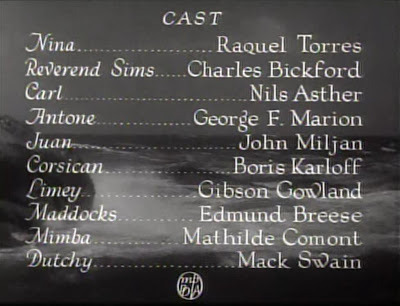
That's right, sixth-billed and playing "Corsican" (which is probably his nationality -- I don't think the character is ever named) is none other than Boris Karloff himself, one year before he became so famous that he was either billed by his last name alone or, even more enigmatically, as "?" (Don't believe me? Click here.) Truth be told, Karloff, like most of the cast, doesn't have a whole lot to do, but he does manage to scowl menacingly when the occasion calls for it...
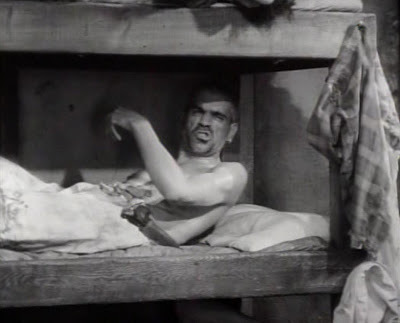
After those credits, we get a couple of interesting text cards setting up the story. (This was at the dawn of sound film, remember, when movies relied on audiences being able to read more than they do now.) An admittedly far-fetched tale is given credibility via National Geographic:
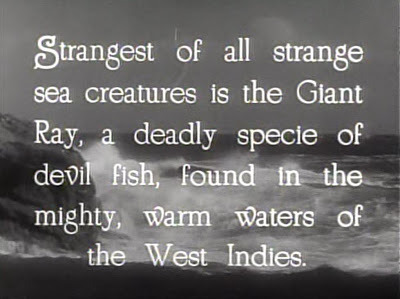
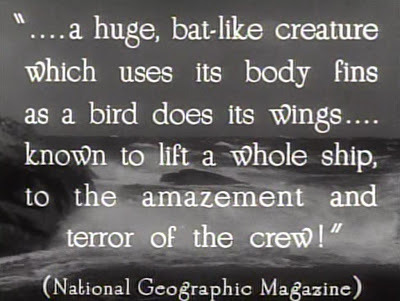
I realize the great thing about science is that it evolves over the years as more knowledge is acquired, but even way back in 1930 did the respected scholars over at National Geographic really believe that the manta ray was a "devil fish" and a "huge, bat-like creature" that was "known to lift a whole ship"? I call shenanigans on this bit of background info, but I love how they tried to convince Depression-era audiences that the hokum (thanks, Leonard) they were about to spring on them was genuine.
Okay, enough foreplay. Let's get to The Sea Bat himself. He arrives near the beginning, when Raquel's doomed brother dives down in search of those sweet, sweet sponges. Even before the monster makes his appearance, the diving scenes are fascinating as a historical artifact. No special effects here, friends. Those are real guys in antique diving suits, and I'm guessing getting those shots was a dangerous undertaking all by itself. This is a long time before scuba tanks were invented, remember...
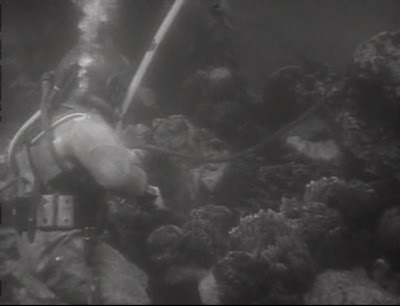
But actual danger or not, the cinematic danger arrives in the form of The Sea Bat. According to the always reliable Wikipedia, manta rays can reach a width of 23 feet, which means that, size-wise at least, "The Sea Bat" is within spitting distance of the realm of possibility. But as far as everything else about a manta ray...
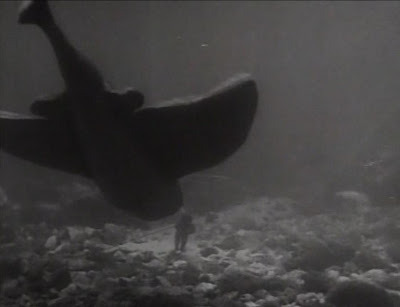
... I remain skeptical about the producers' commitment to verisimilitude. For instance, as seen in the above image, the Sea Bat (shown descending on Raquel's poor, non-voodoo-believing brother) seems a bit thicker than any ray I've ever seen. And I think it has a few extra fins as well.
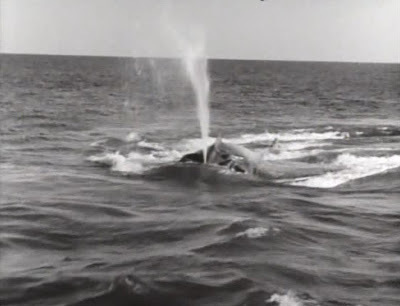
But that's nothing compared to the scenes of the great beast charging along the surface of the water. As you can see, this non-mammal fish like creature has somehow, against all odds, managed to acquire a blowhole. Also, it has somehow acquired both the ability and the desire to charge along the surface of the water. Oh, National Geographic, how could you lend your name to such zoological nonsense?
All complaints about accuracy and blowholes aside, The Sea Bat is a genuinely impressive creation. A few of the shots are miniatures (like that one above of the beast descending on the diver), but in most of the scenes, The Sea Bat is a full-size effect, either pulled by a boat or driven by a motor underneath. Believe me, it's at least as convincing as the shark in "Jaws" (released 44 years later). What's more, the scenes of The Sea Bat pursuing a small boat at the end were, like "Jaws," shot on open water, which gives the movie a nice sense of scale.
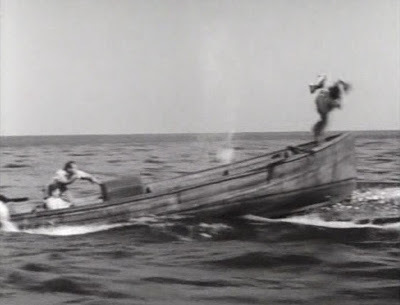
In the shot above, The Sea Bat is pushing the boat containing our hero (Bickford) and the villain trying to turn him in for the reward (which, in most other movies, would make him the hero). It's not exactly a state-of-the-art effect in 2013, but the fact that something actual-sized is about to flip an actual boat makes the moment more effective than it has any right to be.
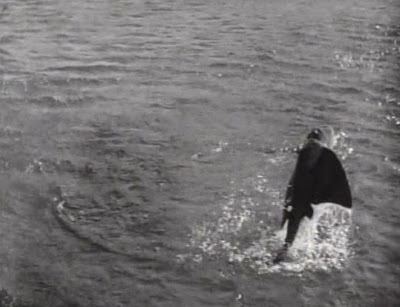
That sense of scale gets thrown out the window moments later when The Sea Bat exits, its mission accomplished and the hero free to romance Raquel Torres once again. Still, the image of this strangely shaped beast flying above the waves for a moment of glorious triumph is so wonderfully implausible (make that impossible) that any fan of monster movies or special effects is bound to appreciate it. After all he's done (kill three people, one good and two bad), The Sea Beast has earned his literal moment in the sun.
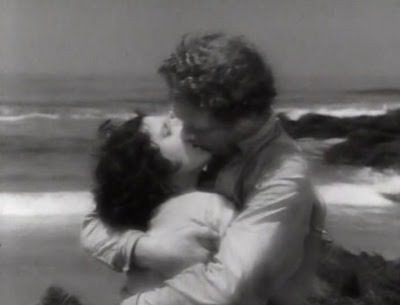
After that, all that's left for the movie is to return Charles Bickford to the loving arms of Raquel Torres for the final fade out. Not a bad ending, and a surprisingly upbeat one (even though the reformed Bickford decides to return to Devil's Island to serve the rest of his sentence). But there's a reason the movie isn't called "The Fake Priest and the Island Girl." If this forgotten movie is worth remembering 80-plus years later, it's not because of them. It's because of The Sea Beast.
Released in 1930 by MGM, "The Sea Bat" screened this week on Turner Classic Movies. Intrigued by the description, which said something about Raquel Torres seeking vengeance on a giant sting ray that killed her husband, I set the DVR and forgot about it. I knew Raquel Torres (real name Paula Osterman -- though she was Mexican) from "Duck Soup," so I figured the Marx Brothers connection alone was worth tuning in for. Plus, that whole "giant sting ray" angle sounded interesting. I've seen a lot of movies about giant monsters, but I had to admit, I hadn't seen one of those before. Plus, I was curious to see how the special effects would be handled. 1930, keep in mind, was a year before the horror movie boom began with 1931's "Dracula" and "Frankenstein" and three years before the giant monster classic "King Kong."
So the next day I plopped down on the couch, fired up the remote and was greeted with this...

Though his name is big (and italicized!), director Wesley Ruggles was, according to the occasionally reliable Internet Movie Database, replaced during filming by none other than the great Lionel Barrymore, which by itself makes this movie worth a look. And, I'm happy to say, there are plenty of other reasons to give "The Sea Bat" a look, too.
For one thing, that TCM plot description both barely scratches the surface and is partly wrong. (It's Torres' brother, not her husband, who dies at the fins of The Sea Bat.) I looked for the movie in all my usual reference spots -- Weldon's "Psychotronic" volumes, the various "Forgotten Horrors" books, William Everson's "Classics of the Horror Film," Carlos Clarens' "An Illustrated History of the Horror Film," even Phil Hardy's massive "Encyclopedia of Horror Movies" -- and I got nothing. Leonard Maltin did have this to say, giving the movie two stars:
"Primitive potboiler about an escaped convict (Bickford) posing as a priest, falling for island vamp Torres and getting involved with pagan voodoo charms and rival sponge divers who are trying to capture a deadly stingray. Ripe hokum sparked by vividly shot action scenes."At least Leonard (or whatever intern he assigned to watch "The Sea Bat") got most of the plot right. Bickford is the biggest presence (and best actor) in this film, playing a Devil's Island escapee hiding behind a bible and a collar. And the whole plot does revolve around, of all things, sponge diving. That's what gets the heroine's brother into the water (he laughingly rejects the voodoo protection charm she offers him, saying his cross will keep him safe. Spoiler alert: It doesn't.) But I'm getting ahead of myself. Besides the titular Sea Bat, Lionel Barrymore behind the cameras and the undeniable charms of a pre-"Duck Soup" Raquel Torres, the cast also boasts another big name... before he became a big name:

That's right, sixth-billed and playing "Corsican" (which is probably his nationality -- I don't think the character is ever named) is none other than Boris Karloff himself, one year before he became so famous that he was either billed by his last name alone or, even more enigmatically, as "?" (Don't believe me? Click here.) Truth be told, Karloff, like most of the cast, doesn't have a whole lot to do, but he does manage to scowl menacingly when the occasion calls for it...

After those credits, we get a couple of interesting text cards setting up the story. (This was at the dawn of sound film, remember, when movies relied on audiences being able to read more than they do now.) An admittedly far-fetched tale is given credibility via National Geographic:


I realize the great thing about science is that it evolves over the years as more knowledge is acquired, but even way back in 1930 did the respected scholars over at National Geographic really believe that the manta ray was a "devil fish" and a "huge, bat-like creature" that was "known to lift a whole ship"? I call shenanigans on this bit of background info, but I love how they tried to convince Depression-era audiences that the hokum (thanks, Leonard) they were about to spring on them was genuine.
Okay, enough foreplay. Let's get to The Sea Bat himself. He arrives near the beginning, when Raquel's doomed brother dives down in search of those sweet, sweet sponges. Even before the monster makes his appearance, the diving scenes are fascinating as a historical artifact. No special effects here, friends. Those are real guys in antique diving suits, and I'm guessing getting those shots was a dangerous undertaking all by itself. This is a long time before scuba tanks were invented, remember...

But actual danger or not, the cinematic danger arrives in the form of The Sea Bat. According to the always reliable Wikipedia, manta rays can reach a width of 23 feet, which means that, size-wise at least, "The Sea Bat" is within spitting distance of the realm of possibility. But as far as everything else about a manta ray...

... I remain skeptical about the producers' commitment to verisimilitude. For instance, as seen in the above image, the Sea Bat (shown descending on Raquel's poor, non-voodoo-believing brother) seems a bit thicker than any ray I've ever seen. And I think it has a few extra fins as well.

But that's nothing compared to the scenes of the great beast charging along the surface of the water. As you can see, this non-mammal fish like creature has somehow, against all odds, managed to acquire a blowhole. Also, it has somehow acquired both the ability and the desire to charge along the surface of the water. Oh, National Geographic, how could you lend your name to such zoological nonsense?
All complaints about accuracy and blowholes aside, The Sea Bat is a genuinely impressive creation. A few of the shots are miniatures (like that one above of the beast descending on the diver), but in most of the scenes, The Sea Bat is a full-size effect, either pulled by a boat or driven by a motor underneath. Believe me, it's at least as convincing as the shark in "Jaws" (released 44 years later). What's more, the scenes of The Sea Bat pursuing a small boat at the end were, like "Jaws," shot on open water, which gives the movie a nice sense of scale.

In the shot above, The Sea Bat is pushing the boat containing our hero (Bickford) and the villain trying to turn him in for the reward (which, in most other movies, would make him the hero). It's not exactly a state-of-the-art effect in 2013, but the fact that something actual-sized is about to flip an actual boat makes the moment more effective than it has any right to be.

That sense of scale gets thrown out the window moments later when The Sea Bat exits, its mission accomplished and the hero free to romance Raquel Torres once again. Still, the image of this strangely shaped beast flying above the waves for a moment of glorious triumph is so wonderfully implausible (make that impossible) that any fan of monster movies or special effects is bound to appreciate it. After all he's done (kill three people, one good and two bad), The Sea Beast has earned his literal moment in the sun.

After that, all that's left for the movie is to return Charles Bickford to the loving arms of Raquel Torres for the final fade out. Not a bad ending, and a surprisingly upbeat one (even though the reformed Bickford decides to return to Devil's Island to serve the rest of his sentence). But there's a reason the movie isn't called "The Fake Priest and the Island Girl." If this forgotten movie is worth remembering 80-plus years later, it's not because of them. It's because of The Sea Beast.
Published on March 10, 2013 14:13
No comments have been added yet.
Will Pfeifer's Blog
- Will Pfeifer's profile
- 23 followers
Will Pfeifer isn't a Goodreads Author
(yet),
but they
do have a blog,
so here are some recent posts imported from
their feed.



